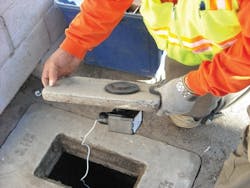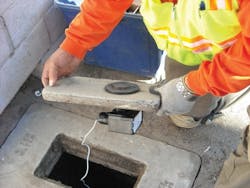By Dr. Andrew Eaton
Hexavalent chromium, the contaminant made popular in the Julia Roberts movie Erin Brockovich, has been a hot topic both within the water industry and among the public in recent months following a report in December by an environmental group showing the presence of the contaminant in 35 U.S. cities' water supplies.
While the presence of hexavalent chromium, also called chromium 6, in U.S. drinking waters comes as no surprise, the report and the public reaction it drew prompted the EPA to recommend utilities across the U.S. begin voluntary monitoring for hexavalent chromium.
So, what do utilities and others need to know about the contaminant, and what else are utilities likely to see regulation on in the near future?
Background
Hexavalent chromium in most drinking supplies originates from natural sources. Chromium is naturally occurring in many rocks, and hexavalent chromium is generally the stable form in water. There is much debate about the levels at which hexavalent chromium poses a public health threat, with levels up to 10 parts per billion (ppb) being fairly common in cities that do the testing. Regulatory compliance monitoring for total chromium showed that more than 15% of water supplies have over 10 ppb. In Hinkley, Calif., where Erin Brockovich came to notoriety, levels were reported at 580 ppb (over 5 times the current allowable level for total chromium)and tied to industrial activities by the Pacific Gas and Electric facility.
The presence of hexavalent chromium in U.S. drinking waters is not a new revelation. The EPA has had standards for total chromium in place for over a decade, and there is evidence that the majority of total chromium in water supplies is hexavalent chromium. California utilities have tested for it for a decade and more than 65% of samples have had hexavalent chromium over 1 ppb.
The Environmental Working Group (EWG) released a report on Dec. 20 revealing the presence of hexavalent chromium (Cr+6) in drinking water from 35 utilities around the country. The cities with the highest levels were Norman, Okla., which was reported to have levels at 12 parts per billion (ppb), and Honolulu, which was reported to have levels at 2 ppb.
Until the EWG report, there was limited public attention to hexavalent chromium in drinking water in California and the rest of the country. The media attention garnered by the EWG report changed that, prompting the EPA to encourage utilities to begin testing for hexavalent chromium on a voluntary basis.
Expected results ofnationwide testing
We can expect utilities that do take the EPA's guidance to find hexavalent chromium in their water supplies.
California utilities have tested for chromium 6 for a decade, under the state's unregulated Contaminant Monitoring Rule (CAUCMR). Data collected showed that nearly 15 percent of California drinking water sources had more than 10 parts per billion (ppb) of hexavalent chromium. This number is similar to the national occurrence for total chromium outlined in the EPA's recently completed six-year review. Nearly 18 percent of 159,000 samples from across the country had more than 10 ppb total chromium.
If one assumes the majority of chromium measurements in finished water will occur as hexavalent chromium, which is logical from a geochemical perspective, one can expect that the national occurrence of hexavalent chromium is significant. Further, once the water has been disinfected, it is likely that even most trivalent chromium will be converted to hexavalent chromium. Research conducted by MWH Laboratories in 2001 (Eaton et al, 2001, "The Erin Brockovich Factor"), and presented at the Water Quality Technology Conference demonstrated that parallel measurements of hexavalent chromium and total chromium showed most samples to be essentially 100 percent hexavalent chromium.
The EPA currently has a maximum contaminant level for total chromium and has indicated that further regulation is likely.
Testing Methods
Following the release of the EWG report, the EPA recommended extensive "voluntary monitoring" of hexavalent chromium in source, finished water and distribution system sites, using the most sensitive method, EPA 218.6, which is an ion chromatography-post column reaction method. When method 218.6 was first released, it had a published method reporting limit (MRL) of 0.4 ppb. California used a more conservative reporting limit of 1 ppb, but within a year of passing the California UCMR, the method was revised by instrument vendors to achieve a much greater sensitivity based on the then proposed PHG of 0.2 ppb.
Based on the method revision, the EPA recommended that utilities use an MRL of 0.06 ppb for the voluntary monitoring. Method 218.6 has a nominal holding time of 24 hours, but the regulations allow a holding time of up to 28 days, provided the sample has been properly buffered. Based in part on the data presented in 2001, along with newer holding time tests performed by CDPH and MWH Laboratories, the EPA in its January call for voluntary testing allowed a holding time of five days until the agency could revisit the method.
Testing Protocol Not Defined
Many unanswered questions remain about the voluntary testing of hexavalent chromium and what further action the EPA may take.
So far it is unclear how data collected by utilities will be used. The American Water Works Association (AWWA)has recommended that EPA create a database for housing results of the recommended monitoring and has approached the EPA regarding potential ways to capture the data. EPA is currently reluctant to capture the data because it is a voluntary monitoring program and it would thus be "selective" data capture.
It also is unclear how utilities will be asked to respond when they detect hexavalent chromium in drinking supplies. The EPA is expected to issue further guidance on public notification, including what information to include. Based on the existing occurrence data, it is likely that most utilities conducting monitoring will detect hexavalent chromium, both because of the sensitivity of the method and the ubiquitous occurrence of chromium in rocks. Utilities may choose to disclose whether or not their drinking water meets Safe Drinking Water Act (SDWA) requirements based on total chromium.
Due to the increased public awareness of the issue, it may be worthwhile for utilities to provide the public with context. For example, California set a final public health goal for arsenic of 0.004 ppb, but the state and federal maximum contaminant level (MCL) is still 10 ppb. Currently, the proposed PHG for hexavalent chromium is 0.02 ppb, five times higher than arsenic, so levels comparable to those reported by EWG would still be considered low when comparing the PHG to the MCL.
Other Testing Considerations
There has been some concern over the potential for false positives resulting from leaching of chromium from stainless steel. When measuring at the ultralow levels specified by the EPA, contamination from sources such as sampling devices is always a possibility. So far there does not appear to be any data indicating this to be a significant risk. When measuring at sub-ppb levels, caution is critical. It would most likely be an issue if the taps showed signs of corrosion. A quick way to evaluate the potential would be to sample both a first draw (if taps are not always on) and one after letting the water run for 5 to 10 minutes. The advantage of the multiple sampling points recommended by EPA is the ability to look for consistency in results among sites as a guide to know whether investigation is warranted.
Public Health Risk
How much of a danger hexavalent chromium poses to the public, and at what levels, will be one of the focuses for the EPA to evaluate in the coming year. While there is evidence that hexavalent chromium is a carcinogen when ingested, there is still extensive debate about at what level it becomes a public health risk. The Integrated Risk Information System (IRIS)and OEHHA have used data from the National Toxicology Program (NTP) to establish the carcinogenicity of hexavalent chromium by ingestion. Both groups have noted that hexavalent chromium appears to be reduced completely to trivalent (nontoxic) chromium in the stomach. Carcinogenic effects were only seen at doses in excess of 50,000 ppb. The current data assumes a linear model rather than assuming a threshold level below which there is no effect and that has been a subject of extensive debate in the literature. The NTP report is undergoing external peer review which is anticipated to be completed later this year, at which point EPA will be in a better position to determine the appropriate regulatory action for hexavalent chromium.
Future EPA Action
Following the release of the EWG report, EPA Administrator Lisa Jackson indicated that hexavalent chromium is on a fast track for regulation. The EPA could move to reduce the maximum contaminant level (MCL) for total chromium or announce a new proposed MCL specifically for hexavalent chromium.
In testimony before the Senate Environment and Public Works Committee on Feb. 2, Jackson addressed hexavalent chromium by reiterating the request that drinking water utilities perform extensive testing to determine occurrence. At the same time she noted the 2011 timeline for review of the NTP report and did not provide guidance on specific levels that the agency might consider.
Other Contaminantson the Radar
Last year the EPA announced it likely would propose the first "group" of contaminants to be regulated in fall 2010. While the immediate focus on hexavalent chromium sidelined that announcement, Jackson used her Senate testimony in February to announce EPA's intention to regulate perchlorate within the next two years and to regulate up to 16 volatile organic compounds (VOCs) under the "groups" concept. While there likely will be extensive debate on the proper MCL level, the EPA took an important step toward removing some uncertainty. The proposed group of VOCs is assumed to be the eight regulated VOCs listed in Figure 1.
The EPA also is moving forward with its third set of UCMR rules, which were announced in 2010 and will affect 4,800 public and private utilities across the country including any that serve more than 10,000 people. As proposed, the new rules would require utilities, starting in 2013, to monitor for up to 28 unregulated contaminants (see Figure 2). Based on existing occurrence information for some UCMR3 contaminants, it is likely that some compounds will be detected with frequencies similar to perchlorate in UCMR1 or N-nitrosodimethylamine (NDMA) in UCMR2. This would set the stage for future regulatory decisions.
After seeing the history and the role that press coverage can play in forcing utilities into crisis response mode, utilities may decide to proactively conduct UCMR3 monitoring to assess their vulnerability.
WW
About the Author: Dr. Andrew Eaton is technical director for MWH Laboratories (www.mwhlabs.com), a division of MWH, the global wet infrastructure sector leader and provider of environmental engineering, construction and strategic consulting services.
More WaterWorld Current Issue Articles
More WaterWorld Archives Issue Articles






